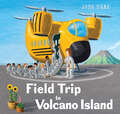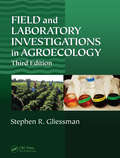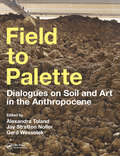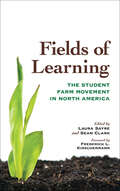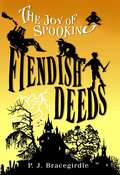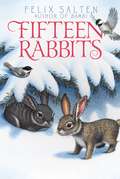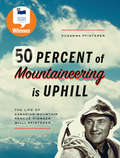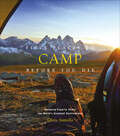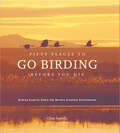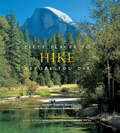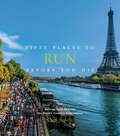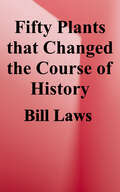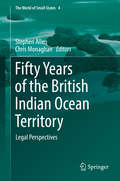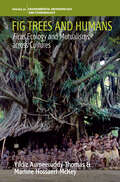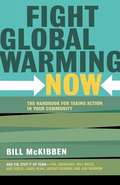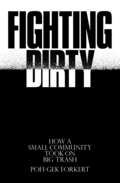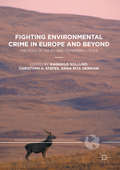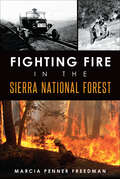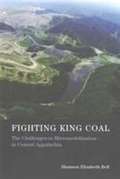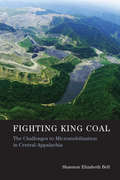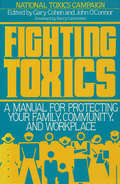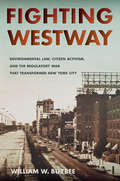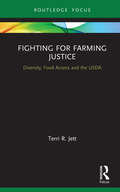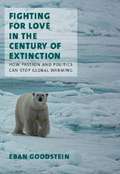- Table View
- List View
Field Trip to Volcano Island (Field Trip Adventures)
by John HareA wordless picture book adventure takes a group of students to visit a thrilling volcanic island. Perfect for fans of Field Trip to the Moon, Field Trip to the Ocean Deep, and field trips in general!John Hare&’s rich, atmospheric art invites all children to imagine themselves in the story – a story full of surprises and adorable new friends.The same students we met in Field Trip to the Moon and Field Trip to the Ocean Deep travel to a volcano island on a yellow school bus helicopter. When they get there, one student picks flowers as they hike to the top and then accidentally slips down a crater and can&’t get out.The student isn&’t too worried--especially when he meets a lava monster and its children who are fascinated by the flowers. But when they touch them, they burn beyond recognition so the student teaches them how to make a vase using lava from a lava pit, fills it with water from a canteen, and they all sit back to enjoy the flower arrangement until help arrives and rescues the student.A Junior Library Guild Gold Standard SelectionPraise for previous books by John Hare Field Trip to the MoonA Junior Library Guild Gold Standard SelectionA School Library Journal Best Book of the Year A Horn Book Best Book of the Year A Bank Street Best Book of the Year - Outstanding Merit Field Trip to the Ocean DeepA Junior Library Guild Gold Standard Selection"Fans of the previous field-trip story will be pleased to see allusions to it, including character cameos and a glimpse of the space bus."—The Horn Book
Field and Laboratory Investigations in Agroecology
by Stephen R. GliessmanAgroecology is defined as the application of ecological concepts and principles to the design and management of sustainable food systems. Hence, learning can best be achieved through an experiential approach to the topic. Designed to accompany Agroecology: The Ecology of Sustainable Food Systems, Third Edition, Field and Laboratory Investigations i
Field to Palette: Dialogues on Soil and Art in the Anthropocene
by Alexandra Toland Jay Stratton Noller Gerd WessolekField to Palette: Dialogues on Soil and Art in the Anthropocene is an investigation of the cultural meanings, representations, and values of soil in a time of planetary change. The book offers critical reflections on some of the most challenging environmental problems of our time, including land take, groundwater pollution, desertification, and biodiversity loss. At the same time, the book celebrates diverse forms of resilience in the face of such challenges, beginning with its title as a way of honoring locally controlled food production methods championed by "field to plate" movements worldwide. By focusing on concepts of soil functionality, the book weaves together different disciplinary perspectives in a collection of dialogue texts between artists and scientists, interviews by the editors and invited curators, essays and poems by earth scientists and humanities scholars, soil recipes, maps, and DIY experiments. With contributions from over 100 internationally renowned researchers and practitioners, Field to Palette presents a set of visual methodologies and worldviews that expand our understanding of soil and encourage readers to develop their own interpretations of the ground beneath our feet.
Fields of Learning: The Student Farm Movement in North America (Culture Of The Land Ser.)
by Laura Sayre and Sean Clark“Essays from staff on 15 farms . . . illustrate the trials, tribulations and sheer joys of establishing and maintaining such enterprises.” —USA TodayOriginally published in 2011, Fields of Learning remains the single best resource for students, faculty, and administrators involved in starting or supporting campus farms. Featuring detailed profiles of fifteen diverse student farms on college and university campuses across North America, the book also serves as a history of the student farm movement, showing how the idea of campus farms has come in and out of fashion over the past century and how the tenacious work of students, faculty, and other campus community members has upheld and reimagined the objectives of student farming over time. Ranging in size from less than an acre to hundreds of acres, supplying food to campus dining halls or community food banks, and hosting scientific research projects or youth education programs, student farms highlight the interdisciplinary richness and multifunctionality of agriculture, supporting academic work across a range of fields while simultaneously building community engagement and stimulating critical conversations about environmental and social justice. As institutions of higher learning face new challenges linked to the global climate crisis and public health emergency, this book holds continued relevance for readers in North America and beyond.“A timely and hopeful book.” —Jason Peters, editor of Wendell Berry: Life and Work“The opportunity for students to spend time learning on campus farms is not just a good idea—it should be mandatory.” —Gary Hirshberg, President & CEO, Stonyfield Farm“An excellent book, useful for anyone interested in the past, or the future, of the student farm movement.” —Journal of Agricultural & Food Information
Fiendish Deeds
by BracegirdleDo you dare set foot in Spooking? It's the terrible town on the hideous hill -- and Joy Wells is a proud resident. A fan of classic horror stories, Joy is convinced that famous author E. A. Peugeot based his spine-tingling tales on Spooking. Take the eerie similarities between the nearby swamp and the setting of his masterpiece, "The Bawl of the Bog Fiend." Could the story be true? Could the bog fiend be on the loose? Things become truly horrifying when Joy learns that Darlington, the despicable suburban city where she is forced to go to school, is planning to build a water park over her beloved bog. It is up to her to safeguard the endangered area and its secrets. Little does she know that there is someone determined to destroy not only the bog but the town of Spooking itself -- and anyone who dares stand in his way. P. J. Bracegirdle spins a yarn of delicious devilry and macabre mayhem in the very first book of The Joy of Spooking trilogy.
Fifteen Rabbits
by Felix Salten Whittaker ChambersBurrow into this classic tale about a family of rabbits from the author of Bambi.Hops and his young rabbit friends must face all the triumphs and trials in the first year of life in the woods. Life is dangerous in the forest, especially for the fifteen young rabbits who are learning to navigate their home. While there are many wonderful things and other animals to get to know--including a deer by the name of Bambi--there are also dangers, and the constant threat of man. In order to thrive, the rabbits must stick together... Felix Salten's story of the lives of fifteen rabbits is brought back to life in this beautiful repackage.
Fifty Percent of Mountaineering is Uphill: The Life of Canadian Mountain Rescue Pioneer Willi Pfisterer
by Susanna PfistererShortlisted for the Alberta Readers' Choice Award!Fifty Percent of Mountaineering Is Uphill is the enthralling true story of Jasper’s Willi Pfisterer, a legend in the field of mountaineering and safety in the Rocky Mountains. For more than thirty years, Willi was an integral part of Jasper’s alpine landscape, guiding climbers up to the highest peaks, and rescuing them from perilous situations.Originally from Austria, this mountain man came to Canada in the 1950s to assail the Rockies, and stayed to become an integral part of mountain safety in Western Canada and the Yukon. His daughter, Susanna Pfisterer, has shaped his stories and lectures as an engaging and educational adventure story that features over 100 archival photographs, including avalanches in the National Parks, highlights from climbing 1,600 peaks and participating in over 700 rescues, and guiding adventures with prime ministers. Accompanied by the humorous wisdom of the “Sidehillgouger,” readers will traverse an historical and spectacular terrain.
Fifty Places to Camp Before You Die: Camping Experts Share the World's Greatest Destinations (Fifty Places)
by Chris SantellaExplore the world&’s top spots for sleeping under the stars—includes beautiful photos, travel tips, and more! The book features the best destinations for exploring the great outdoors and enjoying the recreational activities that make camping such a time-honored tradition—whether your preference is roughing it in nature or enjoying a campground with all the amenities, a solo hike or a family gathering around the fire. Featuring favorite US National Parks destinations—as well as more exotic locales in Italy, Chile, France, Botswana, Thailand, Germany, and more—Fifty Places to Camp Before You Die provides photographs, helpful if-you-go information, the history behind each site, and tips useful to novice and seasoned campers alike. &“Showcases some of the world&’s most beautiful campsites.&” —The New York Times
Fifty Places to Go Birding Before You Die: Birding Experts Share the World's Geatest Destinations (Fifty Places)
by Chris SantellaIt’s estimated that 50 to 60 million Americans count birding among their hobbies. Some hang feeders in their backyards and accumulate yard lists; others participate in annual “Christmas Counts”; a select few travel to the ends of the earth in an effort to see every bird in the world. With Fifty Places to Go Birding Before You Die, Chris Santella takes the best-selling “Fifty Places” recipe and applies it to this most popular pastime. Santella presents some of the greatest bird-watching venues in the United States and abroad through interviews with prominent birders, from tour leaders and conservationists to ornithologists and academics. Interviewees include ornithologist Kenn Kaufman; David Allen Sibley, author and illustrator of The Sibley Guide to Birds; Rose Ann Rowlett, the “mother of modern birding”; John Fitzpatrick, director of the Cornell Lab of Ornithology; and Steve McCormick, president and CEO of The Nature Conservancy. The places vary from the urban (New York City’s Central Park) to the mystical (the cloud forests of Triunfo in Chiapas, Mexico) to the extremely remote (the sub-Arctic islands of New Zealand). The book includes 40 gorgeous photographs that capture the vibrancy of our feathered friends, and the beautiful places they call home.
Fifty Places to Hike Before You Die: Outdoor Experts Share the World's Greatest Destinations (Fifty Places Ser.)
by Chris SantellaA breathtaking guide to fifty of the world’s greatest locations to hike, as selected by the experts who have been there.Fifty Places to Hike Before You Die is the latest offering in the bestselling Fifty Places series. Chris Santella, along with top expedition leaders, explores the world’s greatest walking adventures. Some, such as the Lunana Snowman Trek in Bhutan and the Kangshung Valley Trek in Tibet, are grueling multiweek adventures at high altitudes. Others, such as Japan’s Nakesando Trail, move leisurely from village to village, allowing walkers to immerse themselves in the local culture. Whether it’s climbing the Rwandan mountains to view mountain gorillas or strolling through bistros along Italy’s Amalfi Coast, there’s a memorable hike at everyone’s level within these 50 chapters. With commentaries from expert trekkers and insider tips that lead the reader off the beaten path, Santella has again captured the special characteristics that make these must-visit destinations.
Fifty Places to Run Before You Die: Running Experts Share the World's Greatest Destinations (Fifty Places)
by Chris SantellaA breathtaking guide to the world’s fifty best places to run, as chosen by experts who’ve been there.The beautiful thing about running is that all you need is a trusty pair of shoes and a little determination. When you can practice a sport almost anywhere, from your own neighborhood to courses across the world, where do you begin? In Fifty Places to Run Before You Die, Chris Santella gathers fifty bucket list recommendations from some of the running world’s most accomplished leaders and athletes, including ultra-runner and record breaker Jim Walmsley; Runner’s World chief running officer Bart Yasso; NPR star Peter Sagal; race director of the Boston Marathon Dave McGillivray; U.S. Olympian Magdalena Lewy Boulet; and internationally recognized endurance athlete Dean Karnazes.Featuring a mix of popular foot races (such as marathons, 10Ks, and endurance runs) and scenic trails off the beaten path, this book divulges what makes each venue unique, offering firsthand anecdotes and practical advice for those who aspire to run there. Discover incredible events and trails both national and international, including the Ultra-Trail du Mont-Blanc in France, the New York City Marathon, the Vancouver Sun Run, the Grand Canyon, the Dolomites in Italy, and the Great Ocean Road Marathon in Australia. Fifty Places to Run Before You Die is the essential travel companion for runners of all levels who seek to conquer new terrain while breaking personal records.
Fifty Plants That Changed the Course of History
by Bill LawsOf course, we are entirely dependent on plants for our food and the air we breathe, but did you know that 5,000 mature English oak trees were used in the construction of Admiral Nelson’s flagship HMS Victory, or that sweet peas were involved in the birth of the science of genetics? King Cotton was the driver of the slave trade, which was the first domino to fall in the American Revolution, and cotton was also the catalyst for the Industrial Revolution. <p><p>These, and many other extraordinary facts in Fifty Plants that Changed the Course of History, highlight the dynamic ways in which plants have influenced human history. This beautifully designed and illustrated volume provides an engaging guide to the fifty key plants that have had the most impact on human history. Packed full of information, the book includes details about the habitat and characteristics of each plant, fact boxes, full colour photographs and lovely botanical illustrations. Weaving together strands of economic, political and agricultural history, each entry is a fascinating look at the most influential plants known to mankind.
Fifty Years of the British Indian Ocean Territory: Legal Perspectives (The World of Small States #4)
by Stephen Allen Chris MonaghanThis book offers a detailed account of the legal issues concerning the British Indian Ocean Territory (Chagos Islands) by leading experts in the field. It examines the broader significance of the ongoing Bancoult litigation in the UK Courts, the Chagos Islanders' petition to the European Court of Human Rights and Mauritius' successful challenge, under the UN Convention of the Law of the Sea, to the UK government's creation of a Marine Protected Area around the Chagos Archipelago. This book, produced in response to the 50th anniversary of the BIOT's founding, also assesses the impact of the decisions taken in respect of the Territory against a wider background of decolonization while addressing important questions about the lawfulness of maintaining Overseas Territories in the post-colonial era.The chapter ‘Anachronistic As Colonial Remnants May Be...’ - Locating the Rights of the Chagos Islanders As A Case Study of the Operation of Human Rights Law in Colonial Territories is open access under a CC BY 4.0 license via link.springer.com.
Fig Trees and Humans: Ficus Ecology and Mutualisms across Cultures (Environmental Anthropology and Ethnobiology #32)
by Martine Hossaert-McKey Yildiz Aumeeruddy-ThomasHumans and figs form hybrid communities within the context of anthropogenic landscapes, supported by biocultural mutualisms driven by traits of Ficus species and people’s imagination and practices, and where humans also positively influence Ficus species ecology. Fig Trees and Humans examines the interactions between the biology and ecology of the genus Ficus and how humans use and think of Ficus species across the tropics and in the Mediterranean region. It demonstrates a high level of convergence of material and symbolic uses of human-fig interactions that affect various aspects of human culture, as well as the ecology of wild or cultivated Ficus species.
Fight Global Warming Now: The Handbook for Taking Action in Your Community
by Bill MckibbenBestselling author Bill McKibben turns activist in the first hands-on guidebook to stopping climate change, the world's greatest threats Hurricane Katrina, a rapidly disappearing Arctic and the warmest winter on the East Coast in recorded history. The leading scientist at NASA warns that we have only ten years to reverse climate change; the British government's report on global warming estimates that the financial impact will be greater than the Great Depression and both world wars-combined. Bill McKibben, the author of the first major book on global warming, "The End of Nature," warns that it's no longer time to debate global warming, it's time to fight it. Drawing on the experience of 'Step It Up,' a national day of rallies held on April 14, McKibben and the 'Step It Up' team of organizers provide the facts of what must change to save the climate and show how to build the fight in your community, church, or college. They describe how to launch online grassroots campaigns, generate persuasive political pressure, plan high-profile events that will draw media attention, and other effective actions. This essential book offers the blueprint for a mighty new movement against the most urgent challenge facing us today.
Fighting Dirty: How a Small Community Took on Big Trash
by Poh-Gek ForkertFighting Dirty tells the story of how one small group of farmers, small-town residents, and Indigenous people fought the world’s largest waste disposal company to stop them from expanding a local dumpsite into a massive landfill. As one of the experts brought in to assess the impact the toxic waste would have on the community, Poh-Gek Forkert was part of the adventures and misadventures of their decades-long fight.
Fighting Environmental Crime in Europe and Beyond
by Christoph H. Stefes Ragnhild Sollund Anna Rita GermaniThis book will bring together the findings of a multi-disciplinary and international research project funded by the European Union (EU). "European Union Action to Fight Environmental Crime" (EFFACE) was a 40-month research project that included eleven European research institutions and think tanks and was led by Ecologic Institute Berlin. EFFACE assessed the impacts of environmental crime as well as effective and feasible policy options for combating it from an multidisciplinary perspective, with a focus on the EU. As part of this project, numerous instances of environmental crime within and outside of the EU were studied and are now presented in this volume. This edited collection is highly innovative in showing not only the many facets of environmental crime, but also how it should be conceptualised and the consequences. An original and rigorous study, this book will be of particular interest to policy makers and scholars of green criminology and environmental studies.
Fighting Fire in the Sierra National Forest
by Marcia Penner FreedmanTo live in the foothills on the periphery of the Sierra National Forest is to live with the certainty of summer wildfires. Each year, from April forward, Californians watch the sky and sniff the air for telltale signs of smoke. While fire remains a constant threat, the strategy for combating it has evolved with the understanding of its beneficial role in the forest environment. Marcia Penner Freedman traces the history of firefighting and fire management from the forest's early years through the policy shifts that began in the 1960s and the measures used today.
Fighting King Coal: The Challenges to Micromobilization in Central Appalachia
by Shannon Elizabeth BellIn the coal-mining region of Central Appalachia, mountaintop-removal mining and coal-industry-related flooding, water contamination, and illness have led to the emergence of a grassroots, women-driven environmental justice movement. But the number of local activists is small relative to the affected population, and recruiting movement participants from within the region is an ongoing challenge. In Fighting King Coal, Shannon Elizabeth Bell examines an understudied puzzle within social movement theory: why so few of the many people who suffer from industry-produced environmental hazards and pollution rise up to participate in social movements aimed at bringing about social justice and industry accountability. Using the coal-mining region of Central Appalachia as a case study, Bell investigates the challenges of micromobilization through in-depth interviews, participant observation, content analysis, geospatial viewshed analysis, and an eight-month "Photovoice" project -- an innovative means of studying, in real time, the social dynamics affecting activist involvement in the region. Although the Photovoice participants took striking photographs and wrote movingly about the environmental destruction caused by coal production, only a few became activists. Bell reveals the importance of local identities to the success or failure of local recruitment efforts in social movement struggles, ultimately arguing that, if the local identities of environmental justice movements are lost, the movements may also lose their power.
Fighting King Coal: The Challenges to Micromobilization in Central Appalachia (Urban and Industrial Environments)
by Shannon Elizabeth BellAn examination of why so few people suffering from environmental hazards and pollution choose to participate in environmental justice movements. In the coal-mining region of Central Appalachia, mountaintop-removal mining and coal-industry-related flooding, water contamination, and illness have led to the emergence of a grassroots, women-driven environmental justice movement. But the number of local activists is small relative to the affected population, and recruiting movement participants from within the region is an ongoing challenge. In Fighting King Coal, Shannon Elizabeth Bell examines an understudied puzzle within social movement theory: why so few of the many people who suffer from industry-produced environmental hazards and pollution rise up to participate in social movements aimed at bringing about social justice and industry accountability. Using the coal-mining region of Central Appalachia as a case study, Bell investigates the challenges of micromobilization through in-depth interviews, participant observation, content analysis, geospatial viewshed analysis, and an eight-month “Photovoice” project—an innovative means of studying, in real time, the social dynamics affecting activist involvement in the region. Although the Photovoice participants took striking photographs and wrote movingly about the environmental destruction caused by coal production, only a few became activists. Bell reveals the importance of local identities to the success or failure of local recruitment efforts in social movement struggles, ultimately arguing that, if the local identities of environmental justice movements are lost, the movements may also lose their power.
Fighting Toxics: A Manual for Protecting your Family, Community, and Workplace
by John O'Connor Barry Commoner Gary Cohen Barry National Toxics CampaignFighting Toxics is a step-by-step guide illustrating how to investigate the toxic hazards that may exist in your community, how to determine the risks they pose to your health, and how to launch an effective campaign to eliminate them.
Fighting Westway: Environmental Law, Citizen Activism, and the Regulatory War That Transformed New York City
by William W. BuzbeeFrom 1971 to 1985, battles raged over Westway, a multibillion-dollar highway, development, and park project slated for placement in New York City. It would have projected far into the Hudson River, including massive new landfill extending several miles along Manhattan's Lower West Side. The most expensive highway project ever proposed, Westway also provoked one of the highest stakes legal battles of its day. In Fighting Westway, William W. Buzbee reveals how environmentalists, citizens, their lawyers, and a growing opposition coalition, despite enormous resource disparities, were able to defeat this project supported by presidents, senators, governors, and mayors, much of the business community, and most unions. Although Westway's defeat has been derided as lacking justification, Westway's critics raised substantial and ultimately decisive objections. They questioned claimed project benefits and advocated trading federal Westway dollars for mass transit improvements. They also exposed illegally disregarded environmental risks, especially to increasingly scarce East Coast young striped bass often found in extraordinarily high numbers right where Westway was to be built.Drawing on archival records and interviews, Buzbee goes beyond the veneer of government actions and court rulings to illuminate the stakes, political pressures, and strategic moves and countermoves that shaped the Westway war, a fight involving all levels and branches of government, scientific conflict, strategic citizen action, and hearings, trials, and appeals in federal court. This Westway history illuminates how high-stakes regulatory battles are fought, the strategies and power of America's environmental laws, ways urban priorities are contested, the clout of savvy citizen activists and effective lawyers, and how separation of powers and federalism frameworks structure legal and political conflict. Whether readers seek an exciting tale of environmental, political, and legal conflict, to learn what really happened during these battles that transformed New York City, or to understand how modern legal frameworks shape high stakes regulatory wars, Fighting Westway will provide a good read.
Fighting for Farming Justice: Diversity, Food Access and the USDA (Earthscan Food and Agriculture)
by Terri R. JettThis book provides a detailed discussion of four class-action discrimination cases that have recently been settled within the United States Department of Agriculture (USDA) and have led to a change in the way in which the USDA supports farmers from diverse backgrounds. These settlements shed light on why access to successful farming has been so often limited to white men and/or families, and significantly this has led to a change for opportunities in the way the USDA supports famers from diverse backgrounds. With chapters focusing on each settlement Jett provides an overview of the USDA before diving into a closer discussion of the four key settlements, involving African American farmers (Pigford), Native Americans (Keepseagle), Woman famers (Love) and Latino(a) farmers (Garcia), and the similarities between each. This title places and emphasis on what is happening in farming culture today, drawing connections between these four settlements and the increasing attention on urban farming, community gardens, farmers markets, organic farming and the slow food movement, through to the larger issues of food justice and access to food. Fighting for Farming Justice will be of interest to scholars of food justice and the farming arena, as well as those in the fields of Agricultural Economics, Civil Rights Law and Ethic Studies.
Fighting for Love in the Century of Extinction: How Passion and Politics Can Stop Global Warming
by Eban GoodsteinThe central idea in Fighting for Love in the Century of Extinction is simple: Unchecked, global warming threatens to destroy one of every two animals, birds, plants, reptiles, forests, fish and other creatures alive today on the earth. This looming ecological collapse will only be arrested if we can articulate and embrace what the natural world means to each of us, and then fight a series of hard political battles to preserve creation. On a subject about which it is easy to feel despair, Goodstein offers a realistic, ambitious, and hopeful political solution to avoid a century of mass extinction, a vision grounded in a moral view that embraces the interconnection of all life forms on the planet. Emerging from his work as both an economist and a leader in the clean energy movement, this passionate book sets a new frame for helping Americans understand global warming as the challenge of our generation. Weaving personal narrative with scientific facts, Goodstein begins with an overview of the current global warming crisis. In Chapters 2 and 3 ("Wealth" and "Knowledge") he explores the question of whether the scale of mass extinction we are beginning to witness in the 21st century has more ominous implications for human welfare than it did in the 20th century. By destroying so much of creation,will we destroy the foundation of our own material prosperity? By tearing out so many pages in the book of life, are we depriving future generations of a vast store of knowledge? In "Spirit," he stresses the need to re-spiritualize the way we talk about the natural world. Without an effective moral language that reflects our deeply felt love of nature and its diversity, effective political action is impossible. "Politics" argues that if we are to hold global heating to the manageable, low end, Americans must stabilize emissions of global warming pollutants and begin to invest tens of billions of dollars every year in clean-energy technology solutions for the future. Stabilizing the climate requires strong leadership from the federal government --we must elect clean-energy leaders into the Senate, the House, and the Oval Office in the next few years. How to do this, by becoming involved in electoral politics, is the subject of the final chapter, "Solutions."
Fighting for the Future of Food: Activists versus Agribusiness in the Struggle over Biotechnology (Social Movements, Protest and Contention #35)
by William A. Munro Rachel SchurmanWhen scientists working in the agricultural biotechnology industry first altered the genetic material of one organism by introducing genes from an entirely different organism, the reaction was generally enthusiastic. To many, these genetically modified organisms (GMOs) promised to solve the challenges faced by farmers and to relieve world hunger. Yet within a decade, this &“gene revolution&” had abruptly stalled. Widespread protests against the potential dangers of &“Frankenfoods&” and the patenting of seed supplies in the developing world forced the industry to change course. As a result, in the late 1990s, some of the world&’s largest firms reduced their investment in the agricultural sector, narrowed their focus to a few select crops, or sold off their agricultural divisions altogether.Fighting for the Future of Food tells the story of how a small group of social activists, working together across tables, continents, and the Internet, took on the biotech industry and achieved stunning success. Rachel Schurman and William A. Munro detail how the anti-biotech movement managed to alter public perceptions about GMOs and close markets to such products. Drawing strength from an alternative worldview that sustained its members&’ sense of urgency and commitment, the anti-GMO movement exploited political opportunities created by the organization and culture of the biotechnology industry itself. Fighting for the Future of Food ultimately addresses society&’s understanding and trust (or mistrust) of technological innovation and the complexities of the global agricultural system that provides our food.
